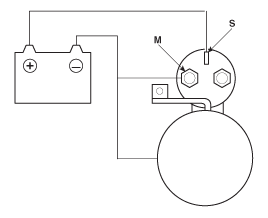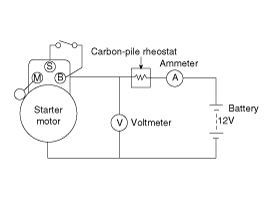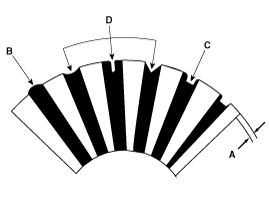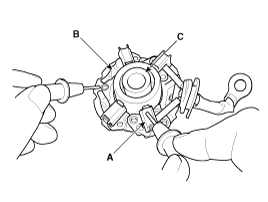Kia Cee'd: Starting System / Starter Repair procedures
| Removal |
| 1. |
Disconnect the battery negative terminal.
|
| 2. |
Remove the air duct and air cleaner assembly.
(Refer to Engine Mechanical System - "Air Cleaner")
|
| 3. |
Disconnect the starter cable (B) from the B terminal on the solenoid
then disconnect the connector from the S terminal (A).
|
| 4. |
Remove the 2 bolts holding the starter, then remove the starter (A).
|
| Installation |
| 1. |
Install in the reverse order of removal.
|
| Disassembly |
| 1. |
Disconnect the M-terminal (A) on the magnet switchassembly.
|
| 2. |
After loosening the 2 screws (A), detach the magnetswitch assembly (B).
|
| 3. |
Loosen the brush holder mounting screw (A) and the trough bolts (B).
|
| 4. |
Remove the rear bracket (A) and brush holderassembly (B).
|
| 5. |
Remove the yoke (A).
|
| 6. |
Remove the packing (A), lever plate (B), lever (C), armature (D).
|
| 7. |
Press the stopper (A) using a socket (B).
|
| 8. |
After removing the stop ring (A) using stopper pliers (B).
|
| 9. |
Remove the stop ring (B), stopper (A), overrunningclutch (C) and armature
(D).
|
| Reassembly |
| 1. |
Reassemble in the reverse order of disassembly.
|
| Inspection |
| Starter Solenoid Inspection |
| 1. |
Disconnect the lead wire from the M-terminal of solenoid switch.
|
| 2. |
Connect the battery as shown. If the starter pinion pops out, it is
working properly.
|
| 3. |
Disconnect the battery from the M terminal.
If the pinion does not retract, the hold-in coil is working properly.
|
| 4. |
Disconnect the battery also from the body. If the pinion retracts immediately,
it is working properly.
|
| Free Running Inspection |
| 5. |
Place the starter motor in a vise equipped with soft jaws and connect
a fully-charged 12-volt battery to starter motor as follows.
|
| 6. |
Connect a test ammeter (150-ampere scale) and carbon pile rheostats
shown is the illustration.
|
| 7. |
Connect a voltmeter (15-volt scale) across starter motor.
|
| 8. |
Rotate carbon pile to the off position.
|
| 9. |
Connect the battery cable from battery's negative post to the starter
motor body.
|
| 10. |
Adjust until battery voltage shown on the voltmeter reads 11volts.
|
| 11. |
Confirm that the maximum amperage is within the specifications and that
the starter motor turns smoothly and freely.
|
| Armature |
| 12. |
Remove the starter.
|
| 13. |
Disassemble the starter as shown at the beginning of this procedure.
|
| 14. |
Inspect the armature for wear or damage from contact with the permanent
magnet. If there is wear or damage, replace the armature.
|
| 15. |
Check the commutator (A) surface. If the surface is dirty or burnt,
resurface with emery cloth or a lathe within the following specifications,
or recondition with #500 or #600 sandpaper (B).
|
| 16. |
Check the commutator diameter. If the diameter is below the service
limit, replace the armature.
|
| 17. |
Measure the commutator (A) runout.
|
| 18. |
Check the mica depth (A). If the mica is too high (B), undercut the
mica with a hacksaw blade to the proper depth. Cut away all the mica
(C) between the commutator segments. The undercut should not be too
shallow, too narrow, or v-shaped (D).
|
| 19. |
Check for continuity between the segments of the commutator. If an open
circuit exists between any segments, replace the armature.
|
| 20. |
Check with an ohmmeter that no continuity exists between the commutator
(A) and armature coil core (B), and between the commutator and armature
shaft (C). If continuity exists, replace the armature.
|
| Starter Brush |
| 1. |
Brushes that are worm out, or oil-soaked, should be replaced.
|
| Starter Brush Holder |
| 21. |
Check that there is no continuity between the (+) brush holder (A) and
(-) plate (B).
If there is continuity, replace the brush holder assembly.
|
| Overrunning Clutch |
| 22. |
Slide the overrunning clutch along the shaft.
Replace it if does not slide smoothly.
|
| 23. |
Rotate the overrunning clutch both ways.
Does it lock in one direction and rotate smoothly in reverse? If it
does not lock in either direction of it locks in both directions, replace
it.
|
| 24. |
If the starter drive gear is worn or damaged, replace the overrunning
clutch assembly. (the gear is not available separately)
Check the condition of the flywheel or torque converter ring gear if
the starter drive gear teeth are damaged.
|
| Cleaning |
| 1. |
Do not immerse parts in cleaning solvent.
Immersing the yoke assembly and/or armature will damage the insulation
wipe these parts with a cloth only.
|
| 2. |
Do not immerse the drive unit in cleaning solvent.
The overrun clutch is pre-lubricated at the factory and sol-vent will
wash lubrication from the clutch.
|
| 3. |
The drive unit may be cleaned with a brush moistened with cleaning solvent
and wiped dry with a cloth.
|
 Starter Schematic diagrams
Starter Schematic diagrams
Circuit Diagram
...
 Starter Relay Repair procedures
Starter Relay Repair procedures
Inspection
1.
Disconnect the battery negative terminal.
2.
Remove the fuse box cover.
3.
Remove the start ...
Other information:
Kia Cee'd JD Owners Manual: Steering wheel audio controls
The steering wheel may incorporate
audio control buttons.
CAUTION
Do not operate audio remote
control buttons simultaneously.
VOLUME (+/-) (1)
Press the lever upward (+) to
increase the volume.
Press the lever downward (-) to
decrease the volume.
SEEK/PRESET (/)
(2)
The SE ...
Kia Cee'd JD Owners Manual: Deleting a Device
Press the key Select
[Phone] Select [Paired Phone List]
From the paired phone list, select the
device you want to delete and press
the button.
✽ NOTICE
When deleting the currently connected
device, the device will automatically
be disconnected to proceed
with the deleting pr ...




























